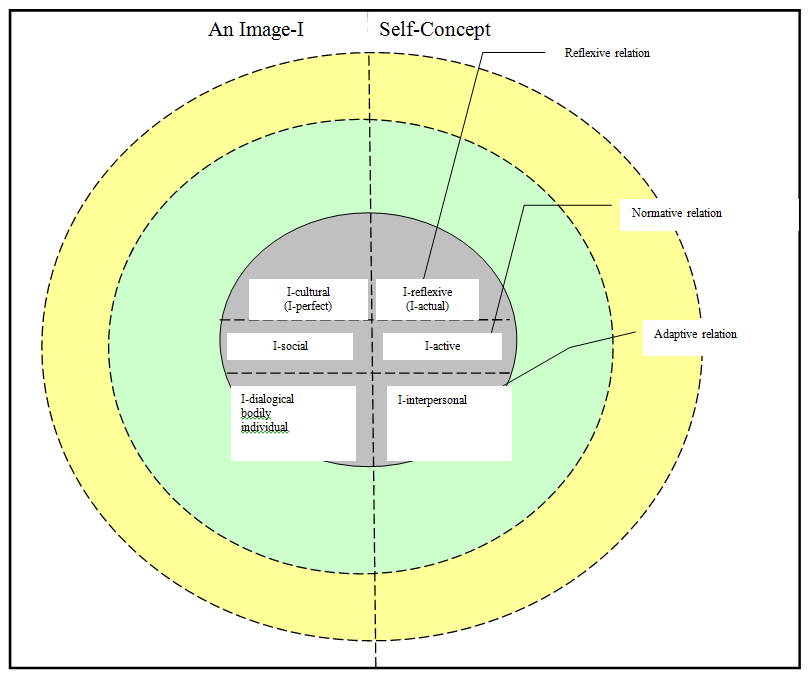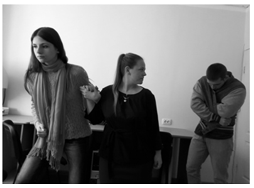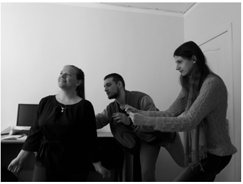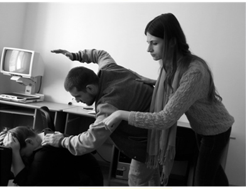Abstract
The article represents the reflexive and dialogical model for developing the creativity of a personality that is tested in the regional center of higher education for people with disabilities. The group for the experiment was chosen by the lessened index of the subjective esteem of a personality life wellness. Developing the concept of a personality life direction was studied with the help of the method of repertory grid. The social reflection technologies for creative interrelations are based on the methods of forming the reflexive and personal aspect to solve creative tasks. The elements of the correlative technique was used for developing interpersonal relations.The research results showed that the dialogue relationships have the important role in developing the personal creativity of the students with disabilities. It is suggested that the connection between the social support and the self-esteem of a person with disabilities is not direct but mediated by the psychological assistance.
Keywords: Inclusive educationreflectiondialogueself-esteemsocial reflection
Introduction
Education as an inseparable part of life is more receptive to globalization and modernization phenomena when the communication problems between various social groups and communities, including the issue of their existence in the educational environment, receive a specific status. The fundamental feature of the teaching activity differs from other educational activity is in its primary appeal to the entire personality and the formation of the active position while overcoming different life situations. A personality having the communicative competences is capable to arrange his or her life, to realize the intentional confident educational activity and to perform the ability to make his/her own choice in the field of education (Aismontas & Odintsova, 2018). For forming the personality identity the inclusive approach to education of people with disabilities has two main ways of identification: the defense directed to isolate negative process impact and the social design as an adaptation to new reality (Os'muk, 2018). The inclusive education requires not only the methods to introduce the integration innovations, but also it demands creating a new thinking philosophy and making the transformation of an educational process (Margolis, Rubtsov, & Serebryannikova, 2017).
One should notice that in the 90s of the XXth century a notion of “culturedigm” was introduced (Semenov & Stepanov, 1989) – that is an integrative characteristic of the common fundamental concept of the reality formed in culture and science. In psychology there is a new research field – reflection psychology that provides the basis for developing a culturedigm in the psychology. The culturological ideas implemented in this trend allowed to highlight the dialogical view of investigating the reflection and constructing the pedagogical concept of the reflexive conversation (Davydova, 2018).
The developed principles and technologies became the base for realizing a theoretical and experimental research of the reflexive dialogue role, of the creativity, of the personality’s self-esteem and one’s cultural identity in the mental and individual development of the students with disabilities.
If one imagines the reflexive and dialogical approach as a new educational alternative, it says about the phenomenon of the psychological support when the cognition is based on the model that the psychotherapy is defined as a “therapy situation”. In contrast to the classical paradigm of the thinking there is the main idea of the dialogical paradigm that can be formulated as the following: the cognition is a constellation of the deepening interpersonal understanding and relations. In the framework of this paradigm the necessary background is represented as taking the researcher’s participation in such interpersonal relations that could be correlated with the principal criteria of the qualitative connections (Rodzhers, 1994). The actual engagement of two people into the cognition procedure can be said as “a united learning subject” (Davydova, 2009).
The person development is determined by forming a certain social and reflexive mechanism connected with the growth of a cultural identity as a person’s valued component (Figure
The cultural identity (I-cultural) is included into the inner (subjective and valued) structure of a person’s self-identity and defined with the terms of attitude of oneself. The external structure is socially determined and conditioned with self-esteem – Self-Concept. A personality evolution is connected with the reflexive relations development and change of one’s bias quality.
A subject position is the reflexive relation on the level of the cultural identity. Such viewpoint corresponds to the most general culture environment where determinations of what a person thinks about the real and about everything that is reasonable in this reality and where one’s activity develops and is limited.

Problem Statement
The higher education institution subsystem needs training teachers who are able to work in the inclusive environment in heterogeneous groups, who are ready to partner interrelations, to provide individual support and to arrange the inclusive practices for professional training (Gluzman, 2018).
Research Questions
The reflexive dialogue as one of the innovative practices related to the personality’s development has some special means (El'konin, 2014) to understand oneself, one’s practical activity and one’s cultural identity. The eventfulness in the reflexive conversation is considered as support to others who try to lean one’s ability to see the things in an objective way due to its attachment to others (Davydova & Semenov, 2016). This active attachment (as a mutual activity of participants in the educational process) should be projected and cultivated in the inclusive education in the framework of certain values and education targets (Rubtsov, Vasina, Kuravskii, & Sokolov, 2017).
Purpose of the Study
The purpose of the study is to analyse how reflexive dialogue helps to construct one’s own relation of a student with disabilities and knowledge, turning it into the educational attitude towards the world in general, included not only in rational explanation but essential subjective experience and one’s cultural identity (Philosophical school).
Research Methods
The reflexive dialogue is performed as the social reflection where its content is represented not only as the rational experience of skills and knowledge but also as the emotional states and where personal emotions revealed in interpersonal relations while solving different life situations. The social reflection principles are correlated with those that are defined by the researchers as a self-reflective talk in group counseling (Logren, Ruusuvuori, & Laitinen, 2017): preparing and creating the personal environment for thinking of under the certain social and cultural context, stimulating the critical thinking by means of a dialogue and supporting to develop different points of view, students’ reflection in future making.
Using the methods of forming the reflexive and personal aspects to solve the creative tasks we have created the typology model of elementary ways of behavior characterizing the interrelations while developing the personality (table
The model represents two reflexive trends to develop the interrelation in a vertical way – the dialogical one (the lower part of the model) represented by three types of a person’s behaviour in a conflict (adaptive, normative, creative), and from the other hand, the destructive one connected with the falling the level of a person’s direction and/or with the forming the accented behaviour ways (regressive, conservative, blocking).
In a horizontal way there are reflexive and personal functions in the process of creative solving the tasks (“motive”, “intention”, “value”, “idea”, “plan”, “action”). The creative one is the entire cycle to solve the problem where the main point is reassessment and transition to the new way of thinking about the problem and its reflexive resolution.
Thus, there are six reflexive competences to develop the reflexive functions of solving the creative task: 1) self-determination with regard to problem and conflict situation; 2) awareness of one’s intentions, all the pros and cons; 3) recognition the wholeness of I, the valued relation to the happening; 4) understanding the purpose, the sense of goal-setting “here and now”; 5) the choice of ways to self-realize, planning; 6) the responsibility for the result (action).
The social reflection supposes two ways to stimulate the professionally oriented students teaching: 1) an exercise to master in a technological way the reflexive essence of the socially constructed reality; 2) a map how to use the social reflection for obtaining the aim (to create a plan how to solve the problems and conflicts in a creative way).
The purpose of the current investigation is to explain methodologically and to design the reflexive dialogue as a model of a person inculturation and the socialization while developing the inclusive education in the higher education institution including the goal-definition, the content, the technologies of growing the creativity and cultural identity of a person with disabilities.
The research hypothesis is that the reflexive dialogue is the innovative method for creative development in the inclusive higher education including the reflexive growth of students with disabilities and it is possible on the background to evaluate the dialogical relations among the participants of the educational process.
The experiment was held using the material of the course “Evaluating the risks of the social and educational environment”. The students of V.I. Vernadsky Crimean Federal University who are enrolled in the studying program “Psychological and pedagogical training” took part in the investigation (56 persons).
The diagnostic part of the experiment made on the basis of the method of repertory grid (Kelly, 2000) revealed the concept of the person life directions according to the following components: perception of the surrounding environment and oneself, the cognitive evaluations how you are satisfied with the certain fields of life, the emotional attitude in general, self-esteem in the relations. There was one group of the students determined who have the lessened index of the self-perception, the contradiction and the low integration of the self-esteem (36 persons).
The main part of the experiment was held in the middle of the semester. The students of the control group (18 persons) had the practical classes in a traditional way (12 hours) using the technologies of developing the reflexive competences in the social and professional interrelations and their applying in designing. The experimental group (18 persons) had the three-staged social and reflexive studying program: 4-hours training course of dialogical relations developing, the second level (4 hours) – is the practical one connected with the social reflection of the arranged interrelation, the third one – is the designed one that includes the knowledge of the disciplines and the reflexive competences. Both groups in the beginning and in the end of the practical part had the test about feelings “now”, and the participants were suggested to give the general self-esteem and evaluation to the partner.
Findings
The investigation led to the idea about the important role of the dialogical relations development (communication) in the situations of the creative self-determination of the students. The criteria of the dialogical relations’ growth are presented by the positive features of self-perception, by the reflexive and comprehensive character of a person’s self-esteem connected with the integrity of the I-actual and I-ideal (An Image I and Self-Concept), and also by the quality of the students’ authentic behaviour.
The creative interrelations between the experimental group participants in the project linked with the occurrence of such notions as “danger”, “risk”, “threat” by means of the alternative communication are depicted in the pictures (Figure
The students were given a task to model the life situations (danger, risk, threat) with the help of the communication system comprising the gestures, some symbols. The future teachers tried to get the emotional realism of their images using the alternative tools to solve the problems of upbringing the children with the difficulties of the verbal communication.



Besides, the students were suggested to comprehend the proposed situations by applying the model of elementary ways of the behavior (table
Teacher. The modern ideas about the nature of the universe based on the chaos theory define the skeptic attitude towards to the guarantees in general, accepting the probable character of most events. The linear, the explanative and the determinative models have exchanged the relativistic one that, unfortunately, makes a human lose one’s hope to rely on one’s knowledge. Nowadays any schoolchild who have read Dostoyevskiy, Bradberry and maybe Levin knows that the minor events are probably have the dramatic finish. Let’s consider few examples.
Student P.: I suggest to regard the situation including the danger taking into account the theoretic thesis that the danger is a peculiarity of the system elements “human – environment”. Thus, two young girls getting home from a party suddenly notice a young well-dressed guy who is standing in a closed position. One of the girls (1) offered to stop and to ask if he was alright. The other girl (2) sad that she felt the danger and proposed to her friend to speed up their step, meanwhile she took out her phone and started to cry loudly as if she was speaking with “her dad”. In a few minutes the guy also used his phone and left quickly.
Situation analysis:
Student B: The people develop the usual ways of adaptation to such situations that helps to live in some way even though reducing a little the sharpness of emotions about the unpleasant feelings. The girl (1) wanted to draw little attention (motivation), it is obvious nothing in her previous experience did not alarm her (intention), the guy figure got the attractive sense for her (value).
Student M: Organisms have the needs for their satisfaction. Particularly, they have to contact with the environment (“value”), but the idea is not in the guy figure but the sense appeared in the relations between the figure and the background. I agree the background was defined by the girl’s (1) desire of the attention.
Student D: As a result due to the girl’s quick wit (2) the fourth step (“the idea”) was presented with the idea to use the telephone and loud crying that is certainly frightening and attracts attention.
Student A: The intentions of this figure (the guy) are introduced here as “plan”, the result became his “action” – he went away as quietly as he appeared.
Student B: One can consider this situation, from the one hand, as the additional experience of the relations with the environment, from the other hand, as the example of the reflexive competence of the girl (2) who prevented her friend’s dangerous intention and surely she protected herself. I think the reflexive technology is able “to work” when the fear or other feelings shut the brain, afterwards one defines the alternative communication, the attention to the feelings, to the intents and the ideas that are to be obvious and clear to everyone”.
It should be noticeable that the social reflection as the unspecific result presented the authenticity of the experimental group and the originality of performed feelings in the communication (pic. 2, pic. 3, pic. 4). The students themselves underlined how it was important to transmit correctly the sensitive aspect of the notions that allows the pedagogical impact to be “persuading”. The statements of the group had the idea that the children with disabilities require the specific stylistics to speak. They are very sensitive to the emotions and can feel insincerity and indifference with ease (Davydova & Semenov, 2016).
The model of the reflexive dialogue in the inclusive education is adaptation and development of a future teacher as a specialist with the high psychological training. These conclusions were made by the researches Dong and Lucas (2016). Their works were devoted to study the relationships between participants of the educational process and adaptation of the students with disabilities. This investigation coincides with the results of our research by the criteria of the importance of psychological support (the person esteem of one’s wealth defined as the subjective assessment of one’s functioning, mood and life satisfaction).
Our investigation showed that the control group comprised from the students who studied in the traditional lecture-seminar way did not show any significant changes of participants’ personalities. It is typical that primarily the lower evaluation of a communication partner stayed underestimated. The social integration of the students in the conflict situation did not influence on feelings and self-esteem changes. Such components as “solitude”, “relations quality”, “reciprocity”, “communication in the social networking sites” left relevant for the most. The students’ reflection in the group work was at the level of the standard decisions and group identity.
This observation is content with the conclusions from the longitudinal research devoted to the social relations impact on the subjective concept of the well-being of people with disabilities (Tough, Siegrist, & Fekete, 2017). The researchers make conclusion that the unwanted or unnecessary social support (including the instrumentation) can have the negative consequences for disabled people causing the reduction of independence, self-evaluation and personal responsibility. Overall it is emphasized that for strengthening the psychological health and well-being of a person with disabilities it is necessary to set up and sustain the relations of a higher quality and also the theory should manage the instrumentation and hypotheses.
Increased reflection of the experimental group of participants was expressed in the growing self-esteem of their own possibilities and also a partner’s professional qualities (there is a strong directly proportional relationship between a self-evaluation and a partner estimate К=0,77 (р<0,05)). The stage associated with the creative design revealed the connection of the personal estimate of the emotional well-being, the creative qualities and also the personal authenticity. The final step of the test showed the significant changes of the qualitative indexes of the experimental group of students characterizing the development of their creativity and cultural identity – the integration, the consistency of I, the balance of the emotional and estimated sphere of a personality, the ability to apply the knowledge in the social and cultural design, to work in a team, to express and to realize their own ideas (67 %). In the control group the changes are just 23 %. The hypothesis is that development of the inclusive group students’ creativity and cultural identity happened because of carrying out the social reflection. It was proved with the experiment results and was grounded by applying Pearson's chi-squared test.
Conclusion
Thus, it is obvious that the development of the direction and cultural identity as the valued component of the creative orientation of the students with disabilities in the inclusive educational process is conditioned with bringing up the personal feelings, the dialogical relations, the reflexive and personal competences, communication, and individual identity.
References
- Aismontas, B. B., & Odintsova, М. А. (2018). Inclusive educational environment of the University as a resource for the development of resilience and self-activation of students with disabilities. Psychological science and education, 23(2), 29–41. https://doi.org/10.17759/pse.2018230204
- Davydova, G. I., & Semenov, I. N. (2016). Investigation of the transformation of the mortido tendencies of the image of self in reflexive-dialogic psychotherapy. Psychology: Historical and critical overview and modern research, 2, 21-48.
- Davydova, G. I. (2009). Reflective dialogue in the educational process of the University (Doctoral dissertation). Retrieved from http://nauka-pedagogika.com/pedagogika-13-00-08/dissertaciya-refleksivnyy-dialog-v-obrazovatelnom-protsesse-vuza
- Davydova, G. I. (2018) Development of the creative orientation of the individual in education: a new paradigm of cognition. Philosophical School, 4, 64–73. https://doi.org/10.24411/2541-7673-2018-1041
- Dong, Sh., & Lucas, M. S. (2016). An Analysis of Disability, Academic Performance, and Seeking Support in One University Setting. Career Development and Transition for Exceptional Individuals, 39(1), 47 – 56.
- El'konin, B. D. (2014). Occurrence of Action (Notes on the Development of Object-Oriented Actions II). Cultural‒historical psychology, 10(1), 11–19.
- Gluzman, Y. V. (2018). Formation of inclusive competence of the training on the master's program «Psychology and pedagogy of inclusive education». Humanities (Yalta), 2(42), 52–56.
- Kelly, G. (2000). Personality psychology. The theory of personal constructs. St. Petersburg: Rech'.
- Logren, A., Ruusuvuori, J., & Laitinen, J. (2017). Self-reflective talk in group counseling. Discourse Studies, 19(4), 422–440. https://doi.org/10.1177/1461445617706771
- Margolis, A. A., Rubtsov, V. V., & Serebryannikova, O. A. (2017). The concept of the project for the development of quality and accessibility of higher education for persons with disabilities in the Russian Federation. Psychological Science and Education, 22(1), 10-17. https://doi.org/10.17759/pse.2017220102
- Os'muk, L. А. (2018). Self-realization of students with disabilities as a basic mechanism of social inclusion. Psychological Science and Education, 23(2), 59–67. https://doi.org/10.17759/pse.2018230207
- Rodzhers, K. R. (1994). A look at psychotherapy. The formation of man. Moscow: Progress.
- Rubtsov, V. V., Vasina, L. G., Kuravskii, L. S., & Sokolov, V. V. (2017). Creating a Model of Special Educational Settings for Disabled Students in Higher Education. Psychological science and education, 22(1), 34-49. https://doi.org/10.17759/pse.2017220106
- Semenov, I. N., & Stepanov, S. Yu. (1989). From the psychology of reflection to the reflective culturalism in psychology. Novosibirsk: IFP SR RAN.
- Tough, H., Siegrist, J., & Fekete, C. (2017). Social relationships, mental health and wellbeing in physical disability: a systematic review. BMC Public Health, 17(1), 414.
- Yacenko, T. S., & Gluzman, A. V. (2015). Methodology of deep-correctional training of a psychologist. Dnepropetrovsk: Innovaciya.
Copyright information

This work is licensed under a Creative Commons Attribution-NonCommercial-NoDerivatives 4.0 International License.
About this article
Publication Date
23 January 2020
Article Doi
eBook ISBN
978-1-80296-077-8
Publisher
European Publisher
Volume
78
Print ISBN (optional)
-
Edition Number
1st Edition
Pages
1-838
Subjects
Teacher, teacher training, teaching skills, teaching techniques
Cite this article as:
Probotyuk*, L. O., Grishko, I. V., Mоtsovkina, E. V., & Davydova, G. I. (2020). Innovative Experience Of Applying The Reflexive Dialogue Model For Students With Disabilities. In R. Valeeva (Ed.), Teacher Education- IFTE 2019, vol 78. European Proceedings of Social and Behavioural Sciences (pp. 113-121). European Publisher. https://doi.org/10.15405/epsbs.2020.01.16
